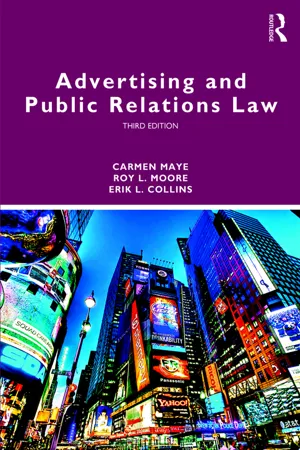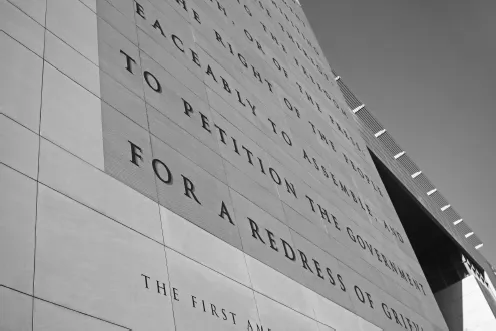Advertising and public relations students and practitioners picking up a 500-plus page book filled with examples and discussions of laws regulating advertising and public relations speech could be pardoned for being somewhat puzzled. After all, the language of the First Amendment to the federal Constitution clearly mandates that “Congress [and, by logical extension, any lesser unit of government] shall make no law … abridging freedom of speech or of the press.”1 How can there be laws regulating any speech (let alone advertising or public relations speech) in the face of the Constitution’s emphatic statement that there can be “no law”? This puzzle requires us to begin with a brief overview of the First Amendment and how it is interpreted, before we turn our attention to the principal subject matter of this book.
Development of First Amendment Jurisprudence
The dilemma for courts faced with deciding cases that challenge the constitutionality of attempts by government to regulate speech and press is that despite the emphatic “no law” language of the First Amendment (see Appendix A), it is almost impossible to believe that those who helped add the amendment to the federal constitution more than 200 years ago meant to protect all speech without exception, even speech, for example, that is treasonous or criminally threatening or harmful to reputation. Yet judges and justices cannot simply ignore the First Amendment because they personally disapprove of the speech in question. Therefore, they have been obliged to develop a logical, rational and defensible method of interpretation by weighing and balancing the interests of those supporting freedom of expression against those favoring competing interests. To understand how they have accomplished this, we need to take a brief look both at how judges interpret law and how historians interpret history.
Role-play the part of judge for a moment. Not a Supreme Court justice but a judge in a lower level court in which the cases usually involve petty crimes and minor disagreements—the kind of court you often see depicted on afternoon or late-evening cable television programs. The next case on the docket is City v. Jones. Testifying for the city is the arresting officer, who reports that the defendant was apprehended at 10 a.m. Saturday and charged with operating a motorized, self-propelled vehicle within a city park. A municipal ordinance (the name often given to laws made at the city or county level) makes such operation illegal for all “persons regardless of status or circumstances.” The law specifies that “all persons violating this ordinance shall be sentenced to (a) no more than 30 and no fewer than 10 days in the city jail, and (b) a fine of no more than $100 and no less than $30.” Because the defendant, Jones, is pleading guilty, this seems like an open-and-shut case for you to decide.
Figure 1.1 The words of the First Amendment to the Constitution of the United States of America are etched into the facade of Newseum, the museum of the press, in Washington, D.C.
Before you pass judgment, however, it seems only fair to hear what the defendant has to say. Unfortunately, Mr. Jones apparently is nowhere to be seen. When you ask the arresting officer “Where’s Jones?” the policeman gestures for you to lean forward and look over the front of your large, desk-like bench. Upon so doing, you discover that “Mr. Jones” is a curly headed, 7-year-old boy, clutching a gigantic toy truck on which a child can sit and ride by winding up a big key on the toy truck’s cab. You’re the judge. Now what do you do? It doesn’t seem right to issue a fine and throw the little kid in the slammer, but it also doesn’t seem right for you to ignore the law that clearly says it applies to all “persons regardless of status or circumstances.”
This rather exaggerated hypothetical case is an example that illustrates a very real dilemma that daily confronts those who must interpret and apply the law to a set of facts. We know what the law says—we can read it over and over. The question is, what does the law mean? This is exactly what judges face when asked to interpret the First Amendment.
Let’s go back to the courtroom where everyone is awaiting your decision. If you thought about looking at the precedent set by other judges who have looked at this municipal ordinance in the past, you are on the right track. Judges do look to prior decisions and the rationales employed by the judges in earlier cases. But they generally don’t stop there. They also may study the literal language of the law or regulation and may take the added step of researching the records of the debate and discussion surrounding its adoption by those who passed it in the first place. Judges often find this legislative history a helpful guide in interpreting and applying the language of the law to the unique set of facts in the cases before them. In addition, they may examine any other historical records that could cast light on the meaning and purpose of a law or regulation.
In our hypothetical case of the little boy arrested for riding on his self-propelled toy truck in the city park, let’s suppose the minutes taken at the city council meeting when the ordinance was passed reveal that the purpose of the municipal ordinance was to block off the streets going though city parks. The rationale was to prevent cars, trucks and buses from running over joggers, bike riders and in-line skaters (and children riding toy trucks) using the paved surfaces in city parks on weekends for recreation. Support for this interpretation is reflected in newspaper articles of the time, reporting both the number of mishaps that had occurred and calls for action by concerned citizens to protect city park users.
With this knowledge, you as judge now have a logical and justifiable reason to dismiss the charges against the boy—after all, he was doing what the law was designed to encourage—and perhaps admonish the arresting officer to be a little less zealous in the future in enforcing this particular ordinance.
These same methods of interpretation can be applied to any law, including the First Amendment. For example, a judge asked to decide a case concerning the constitutionality of a law regulating speech could gather evidence to assist in determining what the First Amendment means (we know what it says) and apply it to the facts of the present case by searching the records of the debates and discussions engaged in by the framers of the First Amendment in 1791.
Strange as it seems, however, such a search would be of little help. The actual discussions were conducted behind closed doors, and it appears the delegates were in enough agreement that the First Amendment should include the words “no law … abridging speech or of the press” that they did not leave a clear record of what they actually meant by those words.
With little specific evidence for determining the literal meaning of the First Amendment available, judges, lawyers and legal scholars have turned to the next best evidence—the historical context of the writing of the First Amendment. This means that those seeking to interpret the First Amendment rely both on their general knowledge about the events in revolutionary America in the late 1700s and their interpretations of historical evidence found in personal diaries, letters, essays and state constitutional provisions written by the framers of the First Amendment.
Figure 1.2 The Supreme Court of the United States has held that “political speech,” or speech related to matters of public concern, is entitled to maximum First Amendment protection.
The outcome of this historical detective work, combined with judicial precedence and evolving judicial philosophies over a more-than-200-year span, has produced the conclusion, now generally accepted by courts and legal scholars, that the framers of the First Amendment did not intend to protect all speech equally. This conclusion has led courts to differentiate categories or levels of speech that receive differing levels of constitutional protection. This protection can range from speech “fully” protected by the First Amendment to speech with no First Amendment protection at all.
Because the drafters of the Constitution envisioned a country in which the people would govern themselves by a process of achieving consensus through deliberation and debate, virtually all legal scholars and practitioners agree that the most protected speech under the “no law” language of the First Amendment is the speech related to “political speech,” what Justice William Brennan once termed “open, robust discussion of public issues.”2 On the other hand, following this analytical approach, speech judged to be obscene or related to criminal activity (e.g., extortion or perjury) is entitled to no First Amendment protection at all. Speech categorized as commercial or over-the-air broadcast falls somewhere in between.
The Tests, Constitutional and Otherwise, for “Fully Protected” Speech
Envision the statue of Lady Justice, blindfolded, holding a set of scales. The scale is perfectly balanced. Normally, if Congress or a federal agency wishes to regulate everyday activities and the government action is subsequently challenged in court as unconstitutional, the government will prevail (i.e., tip the scale in its favor) if it can demonstrate a well-drafted law or regulation designed to accomplish a reasonable government purpose. Sometimes referred to as a “rational basis” test, this historic, court-made rule begins with the assumption that what the government has done is constitutional. It then places the burden on those challenging a government action to demonstrate a lack of rational basis for the law or regulation, usually a difficult burden for the challenger to meet.3
Challenging a law or regulation that arguably abridges a fundamental liberty like protected speech, however, automatically differentiates such a case from the norm. The Court has spent more than eight decades developing an appropriate test to preserve constitutional values when a legislature or agency wishes to regulate “those functions essential to effective democracy.”4
This alternative approach, often referred to as the “compelling government interest test” (sometimes also defined as requiring that a court look with “strict scrutiny” at government attempts to regulate a fundamental liberty) has proven to be a major bulwark in the defense of individual liberties. The test places a heavy burden on the government body wishing to regulate, requiring that it must demonstrate (a) an overriding necessity for its actions, (b) that the law or regulation actually advances the government interest, (c) that it is “narrowly tailored” to accomplish just the limited purpose the government may be permitted and (d) that it is the least restrictive means available to the government for accomplishing its ends.5
Although the Court has never set out a definitive list of these “functions essential to effective democracy,” clearly the right to freedom of speech and press is among ...


